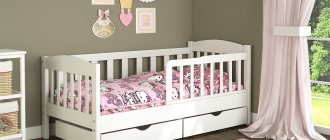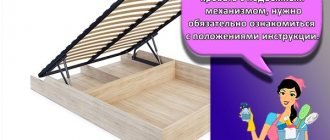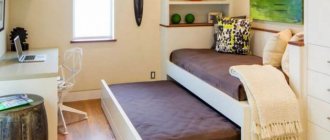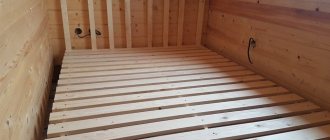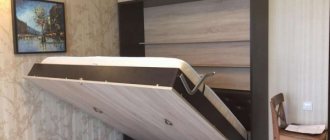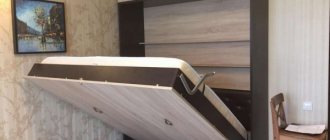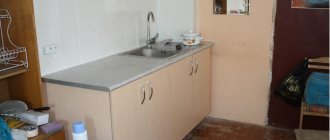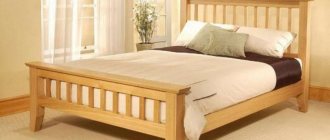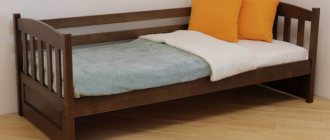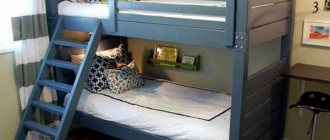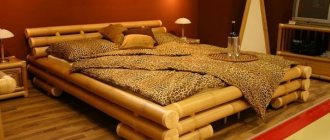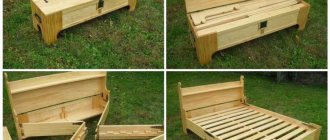People after injuries, as well as during the recovery period after surgery, require special care. For them, manufacturers of medical equipment produce sleeping places that take into account the peculiarities of treatment and rehabilitation during this period. Products such as a bed for bedridden patients are used not only in medical institutions, but also at home. Multifunctional models differ depending on the number of sections, drive type and other parameters. Additional accessories make the couch comfortable and make caring for the patient easier.
Instructions for creating a medical bed at home
The first thing to start with is understanding what exactly this item was needed for.
Most often, its purpose is to raise the patient’s body to a position as close as possible to a sitting position - in order to have lunch, watch a movie, when this is feasible. In situations where the hands have retained their functionality, it is quite possible to get by with a simple option - pillows that you will place under your back in the required volume. But this is not very convenient, and is simply impossible if a person is completely immobilized.
In the latter case, there is no way without the ability to work with tools, ingenuity and dexterous hands. In addition, you will find it useful:
- Two sheets of thick plywood or solid wood. For example, it is possible to take walls from an old cabinet or other similar furniture. The size will depend on the parameters of the bed and the height of the bedridden patient. Ideally, the height will be equal to the body plus a couple of centimeters added (in the place where the pillow is placed). The width matches the width of the bed.
- A wooden partition that will be a good support for the top. There are no important requirements for its dimensions; it all depends on the required lifting height and safety factor.
- Plywood strips for stops.
- Self-tapping screws and hinges for securing them.
In addition, you cannot do without sanding tools, a screwdriver or drill, tape, and varnish if necessary.
It is advisable to process the wood sheets: sand them, smooth out sharp edges. Then mark the places for the hinge holes so that you get a “book” of them. Most often, two hinges are enough, but it is quite possible to take three for reinforcement. A couple more will go to secure the support. Here it is extremely important to accurately determine the height. Only after carefully measuring and checking, connect the rack and plywood.
Next you need to create several stops for the supporting partition - exactly the same number as the number of stages of lifting the body you want to make. As a rule, two or three are enough. They will be placed on a sheet opposite to the one to which the stand is attached. The strips can be glued or secured with self-tapping screws. At the end, make sure that everything works, the finished structure is firmly fixed in various positions.
As a result, to give a complete look, it is highly advisable to cover the resulting structure with several layers of varnish.
This addition to an ordinary bed should be placed under a thin mattress. It is quite possible to use an anti-bedsore device, but it is important to make sure that it does not roll or slide down when lifted. For this purpose, it is fixed or a stop is installed at the bottom of the bed.
Source
Description
- The base of the bed is made of steel profile with environmentally friendly polymer powder coating.
- The headboard and footboard are removable, made of ABS plastic with decorative inserts and equipped with atraumatic corner bumpers.
- The bed has a 4-section system.
- The mattress bed consists of steel supports.
- Sections can be adjusted in angle of inclination.
- Adjustment of the head and hip sections is carried out by 2 mechanical drives.
- The bed wheels have steel load-bearing parts, 2 wheels with individual pedal brakes.
- The bed is equipped with 2 side rails (rails), which can be raised and lowered as needed
- The bed frame has holes for installing a stand-holder for intravenous injections, a device for pulling up and side rails (rails) for the bed.
Devices used at home for bedridden patients
Caring for bedridden patients is a complex and lengthy process. Modern medical equipment, which significantly alleviates the suffering of the patient and the work of his loved ones, is becoming more accessible for use at home. Various devices for bedridden patients sometimes become indispensable for providing comfortable conditions and the possibility of rehabilitation. Many of these devices can be made independently at home.
Design characteristics
The key feature of such beds is the ability to quickly change the configuration. The headboard can be easily raised or removed if you need to wash your hair. The height of the bed is adjustable. Convenient wheels make it easy to transport the patient for examinations or treatment procedures.
Medical beds can be mechanical, semi-automatic or electric. Each type has its own distinctive properties.
| Construction type | Adjustment method | pros | Minuses |
| Mechanical | The head and foot sections are lifted manually and secured with a comb mechanism. The height can be constant or adjustable. | Affordable. | It takes a lot of effort to adjust. |
| Semi-automatic | The upper and lower parts are adjusted by an electric motor. The height of the bed is set manually. The angle of the head, back, and knees changes. | Relatively easy to adjust. | It is difficult for the patient to independently change the height of the bed. |
| Electrically driven | The inclination of the sections is set by the “Autocontour” program. The bed can be moved to the Trendelenburg position (the patient's pelvis is raised by 45°, the back by 80°) and anti-Trendelenburg. Lateral rotation (tilting to the right or left) is also possible. | The patient can independently change the position of the sections. | They are much more expensive and require control of the humidity level in the room. |
Types of devices for bedridden patients
Auxiliary equipment can be useful at any stage of treatment - for caring for a seriously ill patient, providing comfortable conditions for his life, or during the rehabilitation process for a speedy recovery. Devices for caring for bedridden patients at home are freely available; they can be purchased and easily installed in any room.
The main types of assistive devices for caring for bedridden patients:
- Functional beds, the shape of which can be changed depending on the needs of the patient.
- Additional devices: head restraints, restraints, handrails that are necessary to create a safe environment.
- Equipment for hygiene activities: sheet baths, inflatable baths.
- Mobile chairs.
- Lifts for moving patients.
- Exercise machines and tools that are used during rehabilitation.
Beds
The main need for a bedridden patient is a bed. This is where he spends the entire time of his illness. Medical functional beds allow you to create the most comfortable conditions for bedridden people.
Sink grab bars
You need to wash your face every day. It is more convenient to do this if the sink has handrails, because leaning on the plumbing itself is very dangerous.
The handrails can be attached to the wall, or they can frame the bowl and rest on the floor. By the way, they complement the interior well and do not disturb the rest of the household at all. At the same time they can act as a towel holder.
Rehabilitation devices
The recovery period for many diseases requires a long stay in bed and additional activities in order to regain former skills. Special devices for the rehabilitation of bedridden patients will help with this. During the rehabilitation period, patients who have suffered a stroke, brain injury, or severely injured people are forced to develop muscles, regain motor skills in their fingers, and learn to walk again. Various devices will help with this, which can be purchased at a specialized store or constructed with your own hands.
Professional equipment for bedridden patients at home is offered by the following companies:
Rehabilitation simulators have different types. As a rule, this is a simple design that confronts the patient with the task of moving elements. It should not contain small parts, since the motor skills of such patients are poorly developed. An excellent example is a simulator for threading a rope through large wooden beads (the size of a tennis ball) or a wooden block with notches between which you need to move objects.
Important! Rehabilitation is a complex process. The exercises must be performed daily, and the first results may not appear immediately. This stage of treatment should not be neglected. It is imperative to provide the patient with exercise equipment to restore motor functions.
Mechanotherapeutic simulators from Artromot are aimed at restoring joint function. By performing simple tasks of moving objects, the patient stimulates blood flow to the muscles and joints, which significantly speeds up rehabilitation.
proposes the use of myostimulators - devices that, using low-power electrical charges, stimulate muscles to contract. They allow passive training even for bedridden patients.
The Rejoyce device is designed to restore fine motor skills of the fingers.
Materials and safety
Before choosing the type of suitable device to help people with disabilities, you should decide on the product’s material and installation methods that can ensure the proper level of safety, which is paramount in this matter.
Devices for the disabled and elderly are made exclusively from reliable materials - stainless steel, metal composites and complex plastics of high strength and rigidity. Sometimes there are wooden models, you need to be careful with them: it is important to check the quality of fastening of individual elements.
The frames of seats, stands and handrails are made from metals. The places in contact with the skin are usually covered with rubber material or plastic with an anti-slip effect.
Fastening to plumbing fixtures or a wall is necessarily provided for in the instructions for the fixture: each product is designed specifically for a bathtub, shower stall or toilet and follows the shape of the base (wall or contour of the plumbing fixture). When fixing to the wall, use conventional threaded fasteners - self-tapping screws or dowels. There is only one piece of advice in this matter: read the instructions and do not neglect the rules for installing auxiliary devices.
When choosing “helpers”, pay attention to the build quality and place of manufacture - beware of cheap fakes that can harm a person with disabilities. For example, thin plastic breaks under increased weight or force, flimsily connected metal tubes can also be dangerous - no one checks the load-bearing capacity of the frame on such things.
DIY devices for bedridden patients
The described devices for caring for bedridden patients are very useful, but also quite expensive. You don't always have to spend a lot of money to provide comfort to a loved one. If you have time and a pair of skilled hands, you can make your own devices for bedridden patients at home.
For example, a patient needs to take a semi-sitting position in order to eat or to prevent congestive pneumonia in people with heart disease, or simply to relax, watch TV, or communicate with family. In this case, you can come to the rescue with a simple do-it-yourself back support for bedridden patients.
To make a support you will need a set of some materials, namely:
- Three sheets of plywood 10 mm thick - two 1000x1000 and one 860x520 (of course, dimensions in mm);
- Several (for example, 3-5 pcs.) strips of the same plywood for making stops;
- Two sets (4 pcs. in total) of door hinges or two large piano hinges (500-800mm);
- Wood glue;
The design is simple - two meter sheets are fastened on one side with hinges. It is better to attach the hinges to self-tapping screws with a countersunk head. The third is a “spacer” between the resulting “book” of two meter sheets. This “spacer” rests on the joints with the glued strips. The structure is visible in the attached photo.
Naturally, before assembly, the plywood can and should be sanded and, for the sake of aesthetics, can be covered with stain, varnish or other chemical compositions at the request of the craftsman. The overall assembly and operation process is shown in the photo below.
Handrail for shower cabin
A bathtub is not the most convenient hygiene device for people with disabilities, which is why many bathrooms have shower enclosures with a low edge or without one at all. For ease of use, such systems are equipped with a folding handrail. They hold on to it when taking water procedures. When a person who does not need such an “assistant” uses the shower, the handle is simply folded back against the wall.
How to make a bed for bedridden patients with your own hands
Since it is in the bedroom that a person spends the most time in his life, it is necessary that it be as comfortable and practical as possible. This can be achieved by independently designing a medical bed. This is quite easy to do and the process is straightforward. Moreover, the items that will be required to make the structure are considered accessible.
Drawing up a drawing
The do-it-yourself bed for bedridden patients, drawings of which can be found on the Internet, will depend on its purpose.
The simplest option is to create a small support under the back of the person lying down. The structure can be used during meals. This ensures maximum convenience for both caregivers and patients. In addition, it improves the patient’s blood circulation and gives the muscles the necessary load. When creating a diagram of a future product, it is worth considering the dimensions of the original bed. Their width parameters must strictly correspond.
Preparation of materials and tools
Making a bed for bedridden patients with your own hands begins with collecting the necessary items for the work process. First of all, you will need the following materials:
- One sheet of plywood - as a support area - with indicators of 860 * 520 * 5 millimeters;
- There are two of the same parts, only with dimensions of 900*800*10 mm;
- Four plywood strips 860*40*5 mm to make stops;
- Sandpaper.
As for the tools that will help you make a bed for bedridden patients with your own hands, these are:
- Hinge in the amount of 4 pieces;
- 36 nails with 12 millimeters;
- Wood glue;
- A clear varnish specifically designed for furniture;
- Self-tapping screws;
- Roulette;
- Electric drill;
- Screwdriver;
- Hammer;
- Drill;
- Sander.
Assembly of the structure
When all the items are ready, you can begin the main process - preparing materials and constructing the entire structure.
- First you need to arm yourself with sanding and use it to process the plywood layers. It is worth paying special attention to protruding places and possible sharp edges of the product.
- Next you need to take a drill and drill the central holes. It should be smaller than the diameter of the self-tapping screw with a countersunk head. Of course, for convenience, you can pre-mark the markings with a pencil. After the described manipulations are done, you should screw the hinges into the formed recesses, and fix the fundamental part on them.
- Using glue, you should lubricate all existing plywood strips. One of them is a spacer. Next you need to attach them to the inside of the surface. It is best to do this as close to the border as possible. Then everything is secured with nails. All products must be secured so that a space of 70 millimeters is formed between them.
- It is important to make sure that the adhesive has dried and that the products are nailed tightly and securely. The entire structure must be made to the highest possible quality so that it can be used for many years.
- To avoid possible damage to the structure in the future, it is recommended to use varnish for protection. It is advisable to cover it with two layers. This ensures long-lasting use.
As a result, you get an indispensable device that helps a sick person take a half-sitting position in order, for example, to eat, communicate with relatives, or watch TV. In addition, this position of the body is excellent for the prevention of heart disease.
Source
Bathtub with door
If there is no one to help, people with disabilities have difficulty getting into the bathtub to wash themselves. A know-how was invented for them: a bathtub with a door. Typically, it is equipped with a seat and an accessible shower head. Such a plumbing fixture is one of the few opportunities to truly relax and enjoy water procedures without serious effort or outside help. The only point is that you will have to draw water while sitting in a closed bath, as well as drain it.
Specifications
- Dimensions (L x W x H) (± 2%): 2190x960x920 mm
- Bed surface dimensions (L x W) (± 3%): 1970x870 mm
- Bed height (±5%): 500 mm
- Wheel diameter (±5%): 125 mm
- Load capacity (±5%): 200kg
- Head section tilt angle: 0-(75) deg
- Angle of inclination of the hip section: 0-(45) g
Mechanical bed for bedridden patients Armed RS105-B available. Find out how to buy goods with free delivery to Yekaterinburg, Nizhny Tagil, Pervouralsk, Serov, Rezh, Verkhnyaya Pyshma, Bogdanovich and other cities of the Sverdlovsk region and Russia on the “Delivery” page.
Mechanical bed for bedridden patients Armed RS105-B ARMED Description The base of the bed is made of a steel profile with an environmentally friendly polymer powder coating. The headboard and footboard are removable, made of ABS plastic with decorative inserts and equipped with atraumatic corner bumpers. The bed has a 4-section system. The mattress bed consists of steel supports. Sections can be adjusted in angle of inclination. Adjustment of the head and hip sections is carried out by 2 mechanical drives. The bed wheels have steel load-bearing parts, 2 wheels with individual pedal brakes. The bed is equipped with 2 side rails (rails), which can be raised and lowered as needed. The bed frame has holes for installing a stand-holder for intravenous injections, a device for pulling up and side rails (rails) for the bed. Technical characteristics Dimensions (L x W x H) (± 2%): 2190x960x920 mm Bed surface dimensions (L x W) (± 3%): 1970x870 mm Bed height (± 5%): 500 mm Wheel diameter (± 5% ): 125 mm Load capacity (± 5%): 200 kg Head section tilt angle: 0-(60) g Hip section tilt angle: 0-(30) g /upload/iblock/3ee/3ee503d3e9168d18f759fdf9dc000145.jpg 1009836
